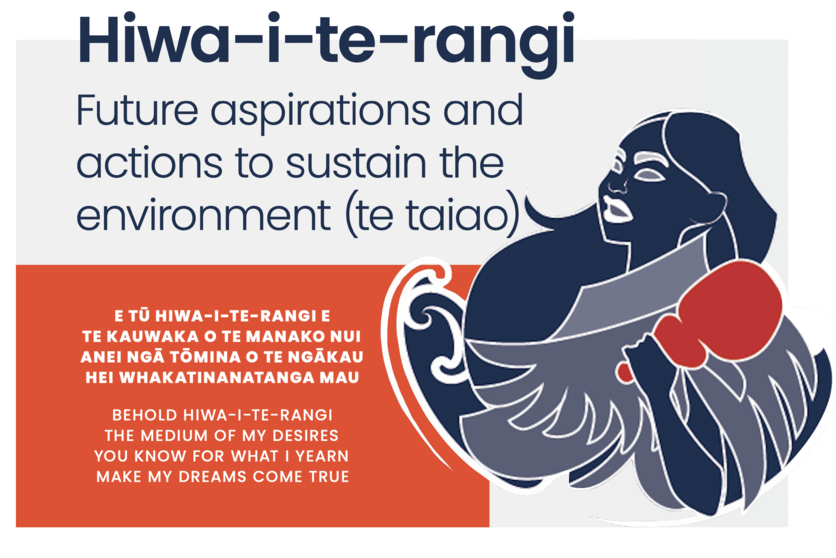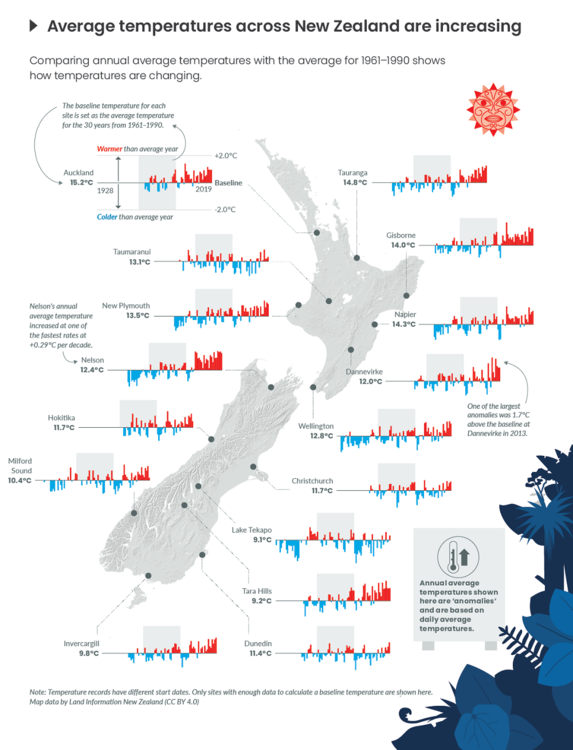Hiwa-i-te-rangi, a whetū in the Matariki cluster, is the youngest child of Rehua and Matariki. Hiwa-i-te-rangi represents our aspirations for a prosperous season ahead. She is connected to looking forward – planning to succeed, hopes for future growth and holding on to a prosperous vision of our future.
Aotearoa New Zealand’s Ministry for the Environment and Stats NZ have produced Environment Aotearoa 2022 as part of its environmental reporting series. Environment Aotearoa 2022 has a unique approach that uses Te Kāhui o Matariki as the guiding framework for the report. Learn more about this approach in the article Environment Aotearoa 2022 – introduction.
Hiwa-i-te-rangi challenges us to look ahead at the complex and interconnected challenges facing us and future generations as well as our ability to adapt to and mitigate future risk.
‘Hiwa’ means ‘vigorous of growth’ and ‘i te rangi’ means ‘in the sky’. Her role is distinct yet connected to those of her siblings in Te Kāhui o Matariki. Her siblings are connected to specific environmental domains and provide tohu in relation to te taiao. The role of Hiwa-i-te-rangi is to pīata (to shine), and provide a light and motivation to step into the unknown. She helps us navigate these signs to move forward.
Environment Aotearoa 2022
Future outlooks
Our values and choices result in pressures on te taiao. Pōhutukawa reminds us of the pressures caused by our use (and overuse) of the land and natural resources, pollution and climate change. These pressures impact ecosystems, habitats and the living things they support. The pressures also affect tangata whenua and all people who call Aotearoa home.
Waipunarangi and Ururangi remind us that weather and climate have shaped both natural and human environments in Aotearoa. Although the weather is often variable, there is evidence to show that the climate is changing. We are already observing changes in our climate and experiencing their impacts. We expect to see higher temperatures across the motu and changing rainfall patterns, with extreme rainfall and droughts becoming more common. Warmer temperatures will impact marine environments and lead to rising sea levels.
Tupuārangi reminds us that climate change can intensify pressures that our native ecosystems already face. Warmer temperatures may allow fungal diseases like myrtle rust to spread more widely. Warmer temperatures also allow pests to move into alpine areas and prey on tiny native butterflies and the iconic takahē. Waitā reminds us that marine habitats are also threatened by marine heatwaves and invasive pests.
Aotearoa plays an important role in helping to feed the world. Climate change has implications for agriculture. Waitī reminds us that the water cycle and hydrology play a key role in water availability from region to region. The unpredictability of rainfall patterns will lead to crops becoming more dependent on irrigation to cope with future droughts.
Challenges provide opportunities for solutions
With a focus on the pressures we’ve placed on te taiao and the growing issues caused by climate change, environmental reports can seem pretty grim. Pōhutukawa reminds us of the duty of care we have for te taiao. Hiwa-i-te-rangi reminds us to look ahead, to adapt to and mitigate future risks.
Environmental reporting provides us with evidence to analyse and inform decisions we need to make for the effective care of te taiao. The purpose of Environment Aotearoa 2019 was to provide “evidence to enable an open and honest conversation about what we have, what we are at risk of losing and where we can make changes”.
Three years on, Environment Aotearoa 2022 continues with this purpose, but signals that the report is only the start of the journey:
Hiwa-i-te-rangi invites us to reflect on these insights and to engage in conversations about our aspirations for the future. Environment Aotearoa 2022 will only serve its purpose if we as individuals, as whānau, and as communities think to the future and how we protect te taiao, our wellbeing, and the wellbeing of future generations.
Environment Aotearoa 2022
Related content and activity ideas
Concept cartoons are ideal for starting conversations and engaging students in meaningful discussions.
- The article Using concept cartoons provides background information and a variety of pedagogical methodologies and approaches.
- The activity Climate change – challenging conversations uses concept cartoons to explore climate change-related issues.
- The activity Using concept cartoons to explore students’ scientific thinking has blank templates for students and teachers to create their own concept cartoons.
Both small and large steps are needed to restore and protect the mauri of te taiao. Each Environment Aotearoa 2022 article includes actions to support the mauri of the whetū and its domain:
- Pōhutukawa – pressures on the environment
- Tupuānuku – land and soil
- Tupuārangi – land-based ecosystems
- Waitī – freshwater environments
- Waitā – ocean and marine conditions
- Waipunarangi – rains, frosts and climate
- Ururangi – air, winds and the sky
The Science Learning Hub team has curated a collection of resources to support Matariki and Environment Aotearoa 2022. This collection provides additional context and pedagogical insights. Log in to make this collection part of your private collection, just click on the copy icon. You can then add additional content and notes and make other changes.
Useful link
Stats NZ and the Ministry for the Environment report on different aspects of Aotearoa New Zealand’s environment every 6 months. Access their reports here.
Acknowledgement
This resource has been produced in collaboration with the Ministry for the Environment and Stats NZ.



